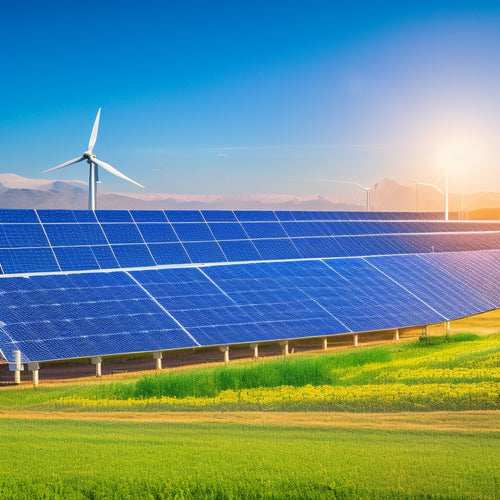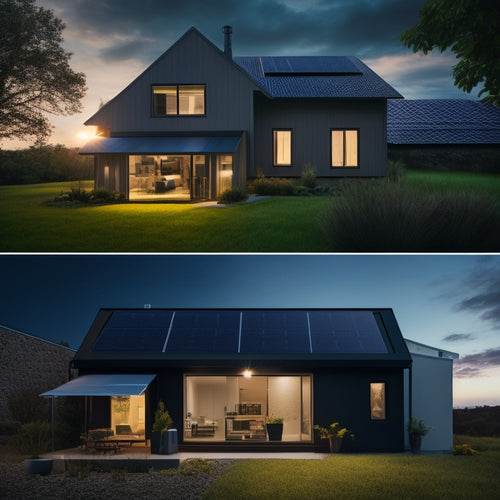
Most Energy-Efficient Green Building Technologies
Share
To maximize energy efficiency in green buildings, you should prioritize innovative technologies. Start with renewable resources like solar panels and geothermal systems to cut reliance on traditional energy. Sustainable materials like high-recycled content options enhance durability and reduce long-term maintenance costs. Smart grid integration and real-time energy management systems help optimize your energy consumption and minimize waste. These technologies not only lower your carbon footprint but also increase property value over time. Consider how these elements can fit into your project scope, and you'll uncover even more ways to enhance efficiency and sustainability.
At a Glance
- Solar Panels: Integrating solar panels harnesses renewable energy, significantly reducing reliance on traditional power sources and lowering energy costs.
- Energy-Efficient HVAC Systems: Advanced heating, ventilation, and air conditioning systems optimize energy use, leading to reduced operational costs and improved indoor air quality.
- High-Performance Insulation: Utilizing sustainable insulation materials enhances thermal efficiency, minimizes energy waste, and ensures consistent indoor temperatures throughout the year.
- Smart Energy Management Systems: These systems provide real-time monitoring and automation, optimizing energy consumption and integrating renewable resources for maximum efficiency.
- Rainwater Harvesting Systems: Implementing rainwater harvesting reduces water usage and utility costs, contributing to overall building sustainability and resource efficiency.
Sustainable Materials Enhance Durability
When you choose sustainable materials, you're not just opting for eco-friendliness; you're enhancing the durability of your building.
By utilizing renewable resources and implementing low-impact manufacturing processes, you create structures that withstand the test of time while minimizing environmental harm.
This strategic approach not only increases resilience but also promotes a healthier planet.
Incorporating energy-efficient solar panels can further enhance the sustainability of your building, ensuring that energy needs are met through renewable sources.
Renewable Resource Utilization
A growing number of builders are embracing renewable resource utilization as a crucial strategy for enhancing sustainability and durability in construction. By integrating solar panels, you can utilize sunlight, reducing your reliance on conventional energy sources.
Wind energy adoption further complements this approach, allowing you to take advantage of natural resources for power generation.
Incorporating geothermal heating systems not only improves energy efficiency but also reduces your carbon footprint. Pair this with rainwater harvesting to optimize water usage, and you create a resilient building that thrives on renewable resources.
Biomass utilization can be another transformative factor, providing an eco-friendly energy source while minimizing waste.
Moreover, energy-efficient landscaping plays an essential role, enhancing your building's aesthetic appeal while promoting biodiversity.
Using passive solar design and thermal mass techniques, you can effectively regulate indoor temperatures, minimizing the need for artificial heating and cooling.
Biophilic design connects you with nature, nurturing well-being and productivity.
Low-Impact Manufacturing Processes
Building on the foundation of renewable resource utilization, low-impact manufacturing processes play an essential role in enhancing the durability of sustainable materials. These processes prioritize eco-friendly production methods that minimize waste and energy consumption, ensuring that resources are used efficiently throughout their lifecycle.
By employing techniques like precision cutting and advanced recycling, manufacturers can create high-quality materials that not only perform well but also contribute to a healthier environment.
When you engage in a lifecycle assessment, you're evaluating the entire process from raw material extraction to disposal. This comprehensive approach allows you to identify opportunities for reducing environmental impact while enhancing the longevity of the materials used in your green building projects.
Moreover, choosing materials that undergo low-impact manufacturing means you're investing in products that resist wear and tear, ultimately saving you money and resources in the long run.
Think of it as a commitment to sustainability that pays dividends—both for your project and the planet. By embracing these innovative processes, you enable yourself to create spaces that aren't only energy-efficient but also enduring and resilient, aligning with your desire for freedom in sustainable living.
Cost Savings Over Time
When you invest in energy-efficient green building technologies, you're not just making an eco-friendly choice; you're setting yourself up for significant long-term savings.
By utilizing financial incentives available for solar installations, you can further enhance your overall cost savings.
Over time, these technologies can drastically cut your energy bills while also minimizing maintenance expenses due to their durable materials and design.
Long-Term Energy Savings
Energy-efficient green building technologies promise significant long-term savings for homeowners and businesses alike. By investing in energy efficiency, you're not just reducing your monthly utility bills; you're also enhancing the value of your property. Over time, the initial costs of green certifications and advanced technologies, such as solar panels or high-performance insulation, pay off considerably.
Imagine slashing energy costs by as much as 30% or more—this isn't just a pipe dream. With smart design choices and sustainable materials, you'll find that the savings compound year after year. The beauty of these technologies lies in their durability and low operational costs, ensuring that your investment continues to yield returns long after the initial expenditure.
Moreover, many green building technologies contribute to a healthier living environment, which can lead to increased productivity and well-being. By embracing energy efficiency, you're liberating not only your finances but also your lifestyle.
As you enjoy reduced energy consumption, you're playing a vital role in promoting sustainability, making a positive impact on the planet while securing financial freedom for yourself. This is the essence of long-term savings in the field of green building.
Reduced Maintenance Expenses
Reduced maintenance expenses are a convincing advantage of energy-efficient green building technologies. By investing in sustainable materials and systems, you can greatly lower your long-term costs.
Energy-efficient buildings often require less frequent repairs and replacements, thanks to their superior design and construction. For instance, high-quality insulation and energy-efficient windows not only minimize energy consumption but also reduce wear and tear on HVAC systems.
Implementing a preventive maintenance plan is essential in this situation. Regular energy audits allow you to identify potential issues before they escalate, ensuring your building operates at peak efficiency.
You'll find that proactive maintenance can save you from costly repairs down the line, further enhancing your financial freedom.
Moreover, green technologies like solar panels and geothermal systems often have lower operational costs, which translates to fewer maintenance headaches. This proactive approach not only keeps your building running smoothly but also contributes to the planet's wellbeing.
Ultimately, reduced maintenance expenses not only safeguard your wallet but also enable you to focus on what truly matters: enjoying the benefits of a sustainable, efficient lifestyle.
Adopt energy-efficient green building technologies, and watch your expenses decrease while your freedom to thrive increases.
Innovative Energy Management Systems
In today's energy environment, integrating smart grid technology is essential for optimizing your building's energy use.
By utilizing real-time performance monitoring tools to track consumption patterns, you can quickly identify inefficiencies and make data-driven decisions that greatly enhance efficiency.
Smart Grid Integration
Smart grid integration revolutionizes how buildings manage energy consumption by harnessing advanced communication technologies and real-time data. By connecting your building to a smart grid, you gain extraordinary control over energy distribution, allowing you to optimize consumption based on demand and supply fluctuations. This integration not only enhances efficiency but also enables you to make informed decisions about when and how to use energy.
One of the most significant smart grid benefits is its ability to facilitate demand response programs. These programs incentivize you to reduce or shift your energy use during peak periods, ultimately lowering costs and easing strain on the grid. With smart grid technology, you can automate these adjustments, maintaining comfort while minimizing energy expenses.
Moreover, integrating renewable energy sources, like solar panels, becomes seamless. The smart grid enables your building to harness locally generated energy, reducing reliance on traditional power sources. This not only cuts your carbon footprint but also promotes energy independence.
In essence, smart grid integration offers you the tools to create a more sustainable, efficient, and flexible energy management system, ultimately aligning with your desire for freedom in energy choices.
Real-Time Energy Monitoring
By implementing real-time energy monitoring systems, you can gain extraordinary understanding into your building's energy use. These innovative technologies allow you to collect and analyze energy data instantaneously, revealing observations that enable you to make informed decisions.
With access to real-time analytics, you'll identify consumption trends and pinpoint inefficiencies that might otherwise go unnoticed. Imagine having the ability to track energy usage at any moment, whether it's during peak hours or when equipment is underperforming.
This transparency not only aids in reducing waste but can also greatly lower operational costs, giving you greater control over your energy expenses. You can set benchmarks and compare your building's performance against industry standards, allowing for continuous improvement.
Moreover, real-time monitoring cultivates a culture of accountability among tenants and staff. When individuals see the immediate impact of their energy choices, they're more likely to adopt sustainable habits.
Ultimately, this system alters energy management from a reactive process into a proactive one, allowing you to optimize performance and enhance your building's overall sustainability. Accept real-time energy monitoring and take charge of your energy future.
Selecting Based on Project Scope
When selecting energy-efficient technologies, you need to carefully assess your project requirements to guarantee the solutions align with your goals.
Consider your budget and resource limitations, as these factors can greatly influence your choices. By clearly understanding these elements, you can make informed decisions that maximize efficiency and sustainability.
Additionally, integrating renewable energy sources can enhance energy independence and reduce long-term costs, allowing for more sustainable practices on your project, such as energy management solutions.
Assessing Project Requirements
Evaluating project requirements is essential for the successful implementation of energy-efficient green building technologies. You need to clearly define your project scope to identify the energy efficiency measures that best fit your objectives.
Start by considering the specific needs of your project—are you aiming for a new build, a renovation, or perhaps a retrofit? Each scenario demands a customized approach to technology selection.
Next, engage with stakeholders to gather information on their expectations and requirements. This collaboration can illuminate unique challenges and opportunities within your project scope.
Don't forget to assess the site conditions, as these can influence which technologies will be most effective. For instance, solar panels might be ideal in sunny areas, while geothermal systems could excel in regions with stable underground temperatures.
Furthermore, compile data on existing infrastructure, as this will help you understand what's feasible within your energy efficiency goals.
By systematically examining all these factors, you'll guarantee that your selected technologies align with the overall vision of your project.
Budget and Resource Considerations
Budgeting for energy-efficient green building technologies requires a careful balance of resources and project goals. As you maneuver this process, consider your project scope and the specific technologies that align with your vision.
Start by identifying your budget constraints; this'll help you prioritize which energy-efficient solutions you can realistically implement.
Explore various financing options, such as green loans, grants, or tax incentives, which can greatly alleviate financial pressures. These resources not only make advanced technologies more accessible but also enhance your project's sustainability profile.
When selecting technologies, weigh their long-term benefits against upfront costs. A more expensive option may offer superior energy savings over time, while a lower-cost solution might lead to higher operational expenses.
By analyzing these factors, you can make informed decisions that align with your fiscal reality without compromising your commitment to sustainability.
Ultimately, embracing energy-efficient technologies isn't just about immediate savings; it's about nurturing a sustainable future.
Lower Carbon Footprint Overall
When you choose sustainable materials for your building projects, you're not just enhancing aesthetics; you're actively reducing your carbon footprint.
Every material selection can either contribute to or mitigate environmental impact, so it's essential to analyze their life cycle.
Sustainable Materials Usage
Incorporating sustainable materials is a groundbreaking factor for reducing the overall carbon footprint of green building projects. By opting for biodegradable materials and those with high recycled content, you're not just making eco-friendly choices; you're actively contributing to a healthier planet.
Biodegradable materials, like hemp or bamboo, break down naturally, minimizing waste in landfills. This choice reflects a commitment to a circular economy, where materials are used and reused rather than discarded.
Recycled content, on the other hand, reduces the demand for virgin resources, thereby lowering energy consumption in production processes. When you select products with recycled materials, you're directly supporting industries that prioritize sustainability.
Imagine using reclaimed wood for flooring or recycled metal for structural components—both visually appealing and environmentally responsible.
Moreover, sustainable materials often come with added benefits like improved indoor air quality and reduced maintenance costs, giving you more freedom to enjoy your living space.
By prioritizing these materials, you're not merely constructing a building; you're building a legacy of sustainability that future generations can admire and benefit from.
Make informed choices, and watch as your project evolves into a guiding light of eco-conscious innovation.
Frequently Asked Questions
What Are the Key Certifications for Green Building Technologies?
To guarantee your building meets sustainability goals, consider key certifications like LEED certification, BREEAM standards, Energy Star, Living Building Challenge, Passive House, and Green Globe. Each represents a commitment to innovative, eco-friendly practices.
How Does Local Climate Affect Energy-Efficient Technology Choices?
Your local climate greatly influences your energy-efficient technology choices. You'll need to take into account climate considerations, adapting technologies to maximize efficiency, whether it's optimizing insulation for cold areas or using passive cooling in warmer regions.
Can Retrofitting Existing Buildings Improve Energy Efficiency?
Retrofitting existing buildings can revolutionize energy efficiency! You'll enjoy significant energy savings and numerous retrofitting benefits, enhancing comfort while reducing your carbon footprint. Welcome innovation and change your space into a sustainable sanctuary.
What Are the Common Misconceptions About Green Building Technologies?
You might think green building technologies are too costly or limited in aesthetics. You may fear maintenance or doubt performance, but many find them accessible and beneficial, overcoming regulatory barriers to create sustainable, innovative spaces that inspire freedom.
How Do Building Occupants Influence Energy Efficiency Outcomes?
Your behavior plays an essential role in energy efficiency. When you're energy aware, simple actions like adjusting thermostats or using natural light can greatly reduce consumption, demonstrating how occupant choices directly influence building performance and sustainability.
Explore More
As you investigate the world of green building technologies, you'll find that choosing sustainable materials not only boosts durability but also leads to significant cost savings over time. Innovative energy management systems can revolutionize how you consume power, while careful selection based on project scope guarantees a customized approach. Ultimately, you're not just reducing your carbon footprint; you're investing in a healthier planet for future generations. Isn't that a legacy worth pursuing? Welcome the change—your choices matter.
Related Posts
-

The Role of Battery Monitoring Systems in Renewable Energy
Battery monitoring systems play an essential role in renewable energy by enhancing system longevity and optimizing pe...
-

Replacing Old Appliances With Sustainable Alternatives
Replacing old appliances with sustainable alternatives can change your home into an energy-efficient space. Not only ...
-

Cost of Home Solar Battery
You're looking to invest in a home solar battery to reduce your grid reliance, but you're curious about the cost. The...


